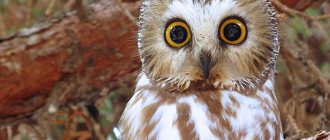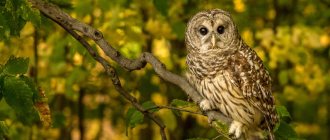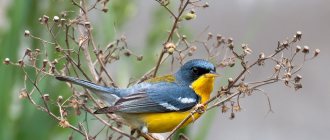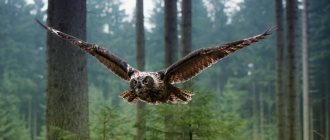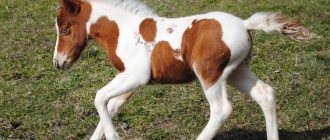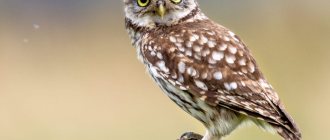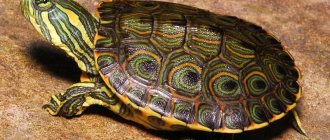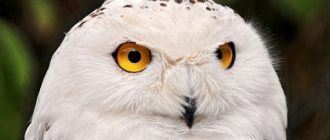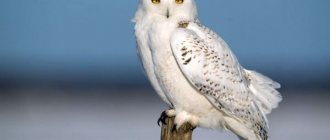Owls are fascinating creatures. It is not for nothing that today many people decide to keep this bird at home as a pet. I must say that people will be disappointed here. Fairy tales about Harry Potter are one thing, but a bird of prey that flies at night and eats raw mice is quite another. It is not suitable for the home, but watching an owl in natural conditions is very interesting.
Amazing desert inhabitants
North American deserts can be amazing in their ecological diversity. A huge number of unique animals live here. They thrive with significant temperature changes and almost complete absence of precipitation.
This is a place of special, harsh beauty where you can meet an amazing creature. It has adapted not only its lifestyle, but also its size to thrive in the desert. The Elven Owl is not a fairy-tale bird, but a real one.
A unique genus of eagle owls
Nocturnal birds with pronounced characteristic feathered “ears” inhabit both Americas, Eurasia and Africa.
Common eagle owl
The common eagle owl has become a living symbol of the game show for connoisseurs. Distinctive features of eagle owls:
- large stocky body 60-75 cm long and wingspan from 1.6 to 1.9 m;
- females weighing from 3000 to 3200 grams are larger than males weighing only 2000 -2700 grams;
- bright orange “piercing” eyes;
- interspersed with orange-brown tones of feather color.
The sedentary live in the forests and steppes of Asia and Europe, feeding on hares, hedgehogs, and rodents. They catch ducks, chickens, crows. They grab them in flight, hit them on the nest, and sometimes even dive for fish. Small game is swallowed alive, larger prey is torn to pieces. Hedgehogs are stripped of their needles, but not always.
There are known cases of eagle owls attacking muskrats and nutria. The loud calling hoot of an eagle owl in the pre-dawn hour spreads 3-4 km around. When worried, the birds make an eerie “laugh.” The rich sound arsenal of common eagle owls includes mournful crying and humming.
Fish owl
Lives in the Far East, unfortunately, being in danger of extinction. The fish eagle owl is distinguished by its massive body size of up to 700 mm and its immense wingspan. Some females gain weight up to 4 kg. The feathers are brown with black specks. There is a light spot on the neck.
Not only the appearance of the birds is unusual, but also their way of life. For food, they catch fish, mainly salmon, weighing up to 1 kg. When hunting, a fish owl dives from the air or goes belly-deep into the water.
In addition to fish, it does not disdain frogs and crayfish. A diurnal species of owls, as they are active in winter during daylight hours. The amazing fish owl wanders a lot on the ground, trampling down entire paths.
The fish owl is a very large bird, some individuals can reach 4 kilograms
polar owl
The white or polar owl inhabits the tundra, surpassing in size other owls of this region. Females measuring 70 cm weigh 3 kg. Males are smaller - 60-65 cm and 2-2.5 kg. The appearance of the white owl is impressive - snow-white plumage with black splashes, orange eyes on a large round head. The feathers on the legs hang down like shaggy wool for protection from frost.
An active twilight predator soars in the air or sits on an elevated surface, looking for prey. The claws can catch mice, lemmings, hares, stoats, partridges, and ducks. When hungry, it picks up carrion and catches fish. However, the polar owl does not hunt near its nest. Geese, geese, waders, and ducks fearlessly build nests in the territory protected by the owl from arctic foxes.
The extraordinary appearance of the snowy owl inspires people to use its image. The polar bird adorns the coats of arms of Norilsk and New Urengoy. A popular writer made a white owl the personal postman of a boy wizard.
How does she look
Petite and cute, it is a common inhabitant of coastal desert areas. This is the smallest of all the owls in the world. Of course, elves have nothing to do with her. I just wanted to emphasize its peculiarity with this name. It can also be given the title of the lightest owl in the world, because its weight is approximately 40 g. Their dimensions are tiny, an adult reaches 14 cm in length, and the wingspan does not exceed 27 cm. If you keep owls at home, then only elven ones. It is not so difficult for them to get food, because they eat almost any insect.
They Can't Chew: Things That Are Very Difficult for Cats to Do
The release of the Resident Evil 4 remake has been postponed to 3023: game development has been restarted
We make a comfortable duvet cover with our own hands: you will need two sheets
The largest owls in the world
The fish eagle owl is a very large representative of owls.
Of course, when talking about different breeds of owls, it is definitely worth highlighting several of the largest ones - often they are of the greatest interest to novice ornithologists.
If you make a list of the five largest, it will look like this:
- The fish eagle owl is truly a huge bird by the standards of the family. With a body length of 70 cm, it weighs up to 4 kilograms, which makes it the largest representative of owls in the world.
- Eurasian eagle owl - their wingspan can reach 180 cm, and in some specimens even 190 cm!
- The great eagle owl lives in the south of North America and there are often individuals in which the distance from the tip of one wing to the other is one and a half meters.
- The polar owl, also known as the white owl, is one of the most famous of its family. Their females are especially large - their body length reaches 70 cm, but the smaller males are rarely more than 60 cm.
- The Philippine eagle owl often reaches a body length of 50 cm, which allows it to be included in the list of the largest representatives of the owl family.
Of course, each of these birds is unique and amazing in its own way. But they also stand out for their very impressive size.
Amazing fact! The maximum speed of an owl when hunting is about 80 kilometers per hour, which is comparable to the speed of a car.
Annual migration
Experts began studying this species of bird and discovered interesting facts about them. It turns out that during the year they migrate over considerable distances. This is due to the harsh characteristics of the region. In spring and fall they are found in the arid deserts of northern Mexico. There they breed and raise their young. They inhabit mainly areas where there are many cacti and tree canyons. They migrate south during the winter, spending the colder months in the warm coastal areas of Mexico.
The role of birds in nature
When studying information about the owl, few people think about the significant role it plays in nature. This bird helps regulate the number of mice, which cause great harm to people when they eat grain in fields and hangars. In addition, owls hunt weakened small animals and birds. Thus they participate in the process of natural selection. This has a positive effect on the natural gene pool.
Owls are also beneficial because they help spread plant seeds. This is of great importance after fires that destroy entire hectares of forest. Thanks to birds, life is emerging again on the scorched earth. Owl droppings are also valuable. It contains organic substances necessary to fertilize the soil.
Variety of species
And here nature has prepared a surprise for us. Although they are similar in many ways, the owls living here are divided into subspecies. It is quite possible that not all of them have been studied yet and the list will soon be replenished with new names. But so far three subspecies of elven owls have been recognized:
- Micrathene whitney idonea. Found only in southern Texas.
- Micrathene whitney sanfordi. Resident of California.
- Micrathene whitney Graysoni lives on Socorro Island.
Unusual owls
African Owls May Surprise Europeans
There are many interesting and unusual owls with surprising distinctive features.
It will be useful to talk about some of them.
- Neotropical owls live only in America, both North and South. The size is medium - the body length is no more than 45 cm. The name was given because of the white stripes and eyebrows that stand out on the almost black plumage, and sharply divide the muzzle into cheeks and eyes.
- The African owl is a real transformer. To scare away opponents, she fluffs up her feathers and tail, increasing in size three times. But in the face of serious danger, it tries to become invisible, pressing the feathers on its body and head, visually decreasing in size by at least two times.
- The steppe or short-eared owl - the main feature of the bird is the fact that it is the only one from the entire vast family that can live perfectly well at home, for example, in a cage or a small aviary.
Interesting! The elf owl is the only bird in the family that eats only plant foods.
Although this is not a complete list, this is already enough to once again be surprised by the diversity of the animal world.
Elf owl in its natural habitat
general description
Now let’s draw a portrait to make it clear what this bird is. The first thing that distinguishes it is its size. It is unusual to see owls of such tiny sizes. Its back and wings are rusty brown. They are scattered with orange-brown spots, which is a natural camouflage that allows them to blend into the desert landscape.
Traveling around Russia and saving: how to get some money back for your trip
Appetizing cakes with a creamy texture in the form of cute flowers
Water scarcity on Earth is increasing: March 22 is World Water Day
The light spot becomes almost white towards the top of the head. A line of contrasting stripes highlights the edge of each wing. The chest and belly are not uniform in color, but rather a mixture of brown and orange stripes.
What is known about the genus of owls
The interpretation of the word “tawny owl” is currently twofold. Some sources refer to the voracity and insatiability of the birds themselves. Others associate the outlandish designation with the inability for a person to eat tawny owl meat as unclean. The numerous genus of these owls includes more than 20 species distributed throughout the world.
Gray owl
The tawny owl adapts well to a variety of natural conditions. They inhabited forests from the Mediterranean Sea to the taiga south. Appearance of an owl from the genus Tawny Owl: a bird with a body length of up to 40 cm and a weight of 500 - 650 grams has plumage the color of tree bark. The wings are relatively short and rounded. Can hunt fairly large birds such as rooks and small animals. During the mating period, males attract females with howling loud hoots.
Listen to the voice of the gray owl
Pallid owl
It settles further south, in palm thickets and rock crevices in the deserts of Egypt, Israel, and Syria. At night it hunts mice and large insects. Approximately 30-35 cm in size, pale colored, light yellow eyes.
Great Gray Owl
A large bird with a length of up to 80 cm and a wingspan of up to one and a half meters. A specific feature of these predators is a black spot under the beak, similar to a beard. They live in Primorye, Transbaikalia, the Baltic states, and western Chukotka. There have been cases of appearance in the Volga forests near Cheboksary. Included in the Red Books of a number of regions of Russia.
Many species of tawny owl are listed in the Red Book
Round eyes and hooked nose
These are typical signs of all owls. But the elven variety is surprising here too. The white feathers that draw the eyebrows are clearly visible on the mask. The color of the head is dominated by orange shades. The nose is gray with a horny tip. The iris of the eyes is mostly yellow.
Unlike most of its relatives, the elf owl does not have ear tufts. There are basically no protruding elements on the small, round head. Their wings are framed in the same way as all other representatives of this species. The special arrangement of the feathers allows for silent flight.
Nest building
The smaller the creature, the greater the threat it is exposed to from predators. And the female is most vulnerable during incubation of eggs, as well as feeding the cubs. Kids themselves are a tasty prey. This is what prompted the owls to find an extraordinary option for protection, that is, to learn to nest in abandoned woodpecker nests.
Desert customs are not unique to owls. Woodpeckers here do not settle on oak trees, but in the soft pulp of giant cacti. This is much easier than chiseling wood with your beak. At the same time, they skillfully make their way inside. On the surface you can see only a small hole, but inside the cavity will be as the master sees fit.
Dresses of Maria Feodorovna and more: The Hermitage made a gift to the Historical Museum
Emigration to the USA and an unsuccessful marriage: how the life of the beauty Natalia Lapina turned out
First country in the world to vaccinate its entire adult population
After the woodpecker leaves its nest, owls occupy the empty niche. Their beak is not very well suited for building a similar house, so they rent ready-made rooms.
Useful work
Woodpeckers hollow out a nesting cavity known as a saguaro boot. They form inside the fleshy pulp of the cactus. The reason is simple: in response to the wounds inflicted by the woodpecker, the plant begins to secrete a resinous liquid. It hardens in air and turns into a strong crust that prevents further loss of moisture. The result is a reliable and comfortable nest for the woodpecker, and then for the elf owl.
There are other people who like to use nests for their own purposes. Desert bees often make hives for themselves in them, filling them with sweet honey. Even when the cacti die, the hard boot remains resistant to decay. Indigenous people used to use them as containers.
Nutrition
In the wild, owls eat food of animal origin. The food supply largely depends on the habitat of the predator. The diet of poultry is dominated by:
- field mice;
- hamsters;
- rats;
- lizards;
- shrews;
- frogs;
- sparrows and other small birds;
- grasshoppers;
- beetles;
- worms;
- the bats.
Owls living near seas and lakes enjoy eating small fish, mussels and crabs. Large birds hunt grouse, pheasants, partridges and hedgehogs.
Important! An owl can go without water for a long time. She compensates for the lack of fluid with the blood of her victims.
Reproduction
We got a little distracted. It is these reliable nests that the female elfin owl chooses to lay 2 - 4 white eggs. Their breeding season is May - June. Males find empty nests and begin to sing. Some do not even leave the nest, so large cacti are echoed with loud trills. Attracted females inspect the future house and if they are satisfied with it, they accept the invitation.
“Creativity and Creativity”: Rosobrnadzor is thinking about transforming the Unified State Exam
Coincidentally or not: why Lady Di put a necklace on her head, which upset the queen
Malaysian artist creates stunning surreal photo illusions
During courtship, the male will feed his partner, showing the seriousness of his intentions. After mating, the female lays eggs and begins incubation. This lasts 21 - 24 days, and the chicks hatch. For several weeks, the mother does not leave the nest with her offspring. The father continues to bring them food.
When young owls are two weeks old, both parents leave the nest to hunt. The offspring grows and requires more food. The chicks will live under the protection of their parents for approximately 40 days, after which they will begin to look for food on their own.
The dangers that await them
Being tiny creatures, they are constantly at risk of becoming prey to larger predators themselves. In the desert, snakes and coyotes and lynxes are ready to hunt them. Large owls and hawks will not refuse to snack on their relatives.
Elven owls are not aggressive, preferring to hide rather than attack. Therefore, they are happy to use cacti in which they can safely hide. And it is also noted that they use a hackneyed technique. If an owl is in danger, it falls to the ground and freezes. The coloring allows you to completely merge with the landscape.
But today they face a different danger. Man is trying to use every hectare of land, cutting down coastal forests. The climate of these places is changing. The use of pesticides leads to a critical decrease in the number of insects that charming owls feed on.
Found a violation? Report content
Common characteristics of all types of owls
Predatory nocturnal representatives of birds are very numerous. There are more than two hundred species of owls in different directions of the world. Ornithologists identify common characteristics that distinguish owls from other birds:
- Amazing owl eyes lack eyeballs. These are eye tubes held in the skull by special bone structures. Therefore, the huge, penetrating eyes are motionless. Birds look forward with both eyes at once, determining the distance and mass of the prey when hunting. With phenomenal farsightedness, the owl sees objects close to it poorly. “Night vision devices” are protected by three eyelids - one blinks, the other maintains cleanliness, and the third serves for sleeping.
Structure of the owl skull
- However, the static nature of the eyes is more than compensated for by the mobile neck. The angle of rotation to the left and right is 1350 thanks to the 14 cervical vertebrae and the special structure of the blood vessels.
- Owls also have excellent hearing. Asymmetrical auditory openings, often of different sizes, do not catch sound waves synchronously. The distance to the source of the slightest rustle is determined with amazing accuracy.
- The owl has discovered where and what kind of prey is hidden, now the task is to fly up silently. Wide wings with a soundproofing border on the feathers leave no chance for the prey to hear the approach of the hunter. The camouflage color blends the bird with the surrounding nature.
- The grip of owls' paws is deadly. Typically, three fingers point forward and one back. In flight, one front finger turns back. It turns out to be a “dead grip”.
This is how, in the process of evolution, ideal feathered hunters appeared on Earth more than 50 million years ago. The order of owls is divided into two families - true owls and barn owls. These include eagle owls, scops owls, tawny owls, and long-eared owls.
The grip of an owl's paws is called "deadly"
